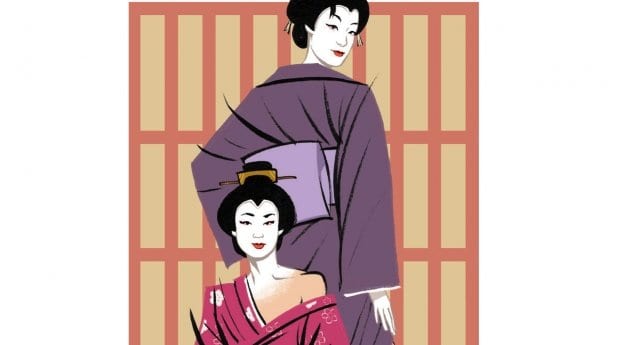In his book Male Colors: The Construction of Homosexuality in Tokugawa Japan, author Gary Leupp describes a scene from the 1742 kabuki play Narukami Fudo Kitayama Zakura. Danjiro, a rakish ronin — a class of masterless samurai — seeks an audience with a lord. While waiting, he is attended by Hidetaro, a beautiful adolescent who offers him tobacco. They discuss Hidetaro’s martial training and Danjiro, complimenting the youth’s beauty, offers to teach the boy horseback riding; he accepts enthusiastically. The ronin squeezes Hidetaro between his thighs, explaining, “Press tightly against the flanks of your mount, thus,” and continues to suggestively simulate good riding technique. A kiss is rebuked, Hidetaro flees, Danjiro laughs and glibly apologizes to the audience for his “shameful” behaviour.
When a woman arrives with tea, Danjiro assaults her with innuendo, playing on slang where “tea” refers to sex with a prostitute. She exits in disgust, and Danjiro turns to the audience, lamenting, “That’s two cups of tea I’ve been denied!”
Japan has a long, rich history of homosexuality or, more often, bisexuality, usually with strong pederastic leanings. Hierarchical elder-youth relationships were common in monasteries, between samurai and their apprentices, or among the middle class and sex workers. The misadventures of Danjiro typify the delightful sexual perversity of the kabuki stage, all the more titillating because, no matter what combination of partners, all the roles were played by men.
Ironically, kabuki — the written characters that make up the word individually mean “song,” “dance” and “skill” — was founded by Izumo no Okuni, a minor Shinto priestess. She was sent from Izumo to Kyoto to perform sacred dances and songs as a means of soliciting donations. Known for her great beauty and sensuous dancing, Okuni started performing on the dry riverbeds of Kyoto around 1603; she attracted a following of female misfits and prostitutes, to whom she taught her craft. These first actors of kabuki played both the male and female roles in erotic skits, and they also often sold themselves after performances.
This art form became popular in red-light districts, with brothels picking up talented prostitutes and forming all-female troupes, which became known as onnakabuki. All-male troupes were also popular, especially youth troupes, known as wakash-kabuki; their actors were just as likely to double as prostitutes.
This was at the beginning of the Edo period, during which the Tokugawa shogunate ruled. The military dictatorship’s means of controlling the people was a rigid class system with limited opportunities for social climbing. The shoguns didn’t like the mixture of classes at the popular kabuki performances, from farmers to samurai to royalty, so they banned women from kabuki in 1629, giving rise to the onnagata.
Onnagata, Japanese for “woman-form,” were heavily made up and intricately dressed male kabuki actors who played all the female roles, speaking in falsetto. Much like drag as we know it today, onnagata represented an impossible fantasy of femininity.
The shoguns’ ban did little to stop the thirst of the masses for kabuki performances and their patronage of the “female” stars. What was between the legs of the performers meant little to the audiences — if anything, androgyny and gender confusion simply provided further titillation — and onnagata were often rented out to clamouring male and female clientele. Onnagata were banned in 1642, replaced by wakash, adolescent male roles often played by youths, and these were eventually banned as well.
The bans on onnagata and wakash roles were eventually lifted, in 1644 and 1652 respectively, on the condition that actors had to take pains to make themselves less attractive, but this did little to dispel the erotic power of the onnagata.
A number of images from kabuki’s heyday depict the infinite erotic combinations the form could afford. A print by 18th-century artist Suzuki Harunobu, for example, shows a man who finds his mistress in bed with an onnagata. Is he filled with murderous anger or disgust? Nope: he climbs into bed with him, fucking the woman while masturbating the other man. Social climbing may have been unheard of in Tokugawa Japan, but kabuki theatre shows how different classes always find ways to come together.
History Boys appears in every issue of Xtra.


 Why you can trust Xtra
Why you can trust Xtra


